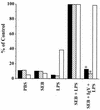Protection against bacterial superantigen staphylococcal enterotoxin B by passive vaccination
- PMID: 11953360
- PMCID: PMC127924
- DOI: 10.1128/IAI.70.5.2278-2281.2002
Protection against bacterial superantigen staphylococcal enterotoxin B by passive vaccination
Abstract
We investigated the ability of two overlapping fragments of staphylococcal enterotoxin B (SEB), which encompass the whole toxin, to induce protection and also examined if passive transfer of chicken anti-SEB antibodies raised against the holotoxin could protect rhesus monkeys against aerosolized SEB. Although both fragments of SEB were highly immunogenic, the fragments failed to protect mice whether they were injected separately or injected together. Passive transfer of antibody generated in chickens (immunoglobulin Y [IgY]) against the whole toxin suppressed cytokine responses and was protective in mice. All rhesus monkeys treated with the IgY specific for SEB up to 4 h after challenge survived lethal SEB aerosol exposure. These findings suggest that large fragments of SEB may not be ideal for productive vaccination, but passive transfer of SEB-specific antibodies protects nonhuman primates against lethal aerosol challenge. Thus, antibodies raised in chickens against the holotoxin may have potential therapeutic value within a therapeutic window of opportunity after SEB encounter.
Figures

References
-
- Arad, G., R. Levy, D. Hillman, and R. Kaempfer. 2000. Superantigen antagonist protects against lethal shock and defines a new domain for T-cell activation. Nat. Med. 6:414-421. - PubMed
-
- Bavari, S., B. Dyas, and R. G. Ulrich. 1996. Superantigen vaccines: a comparative study of genetically attenuated receptor-binding mutants of staphylococcal enterotoxin A. J. Infect. Dis. 174:338-345. - PubMed
-
- Bavari, S., R. G. Ulrich, and R. D. LeClaire. 1999. Cross-reactive antibodies prevent the lethal effects of Staphylococcus aureus superantigens. J. Infect. Dis. 180:1365-1369. - PubMed
-
- Cresswell, P. 1994. Antigen presentation. Getting peptides into MHC class II molecules. Curr. Biol. 4:541-543. - PubMed
MeSH terms
Substances
LinkOut - more resources
Full Text Sources
Other Literature Sources

